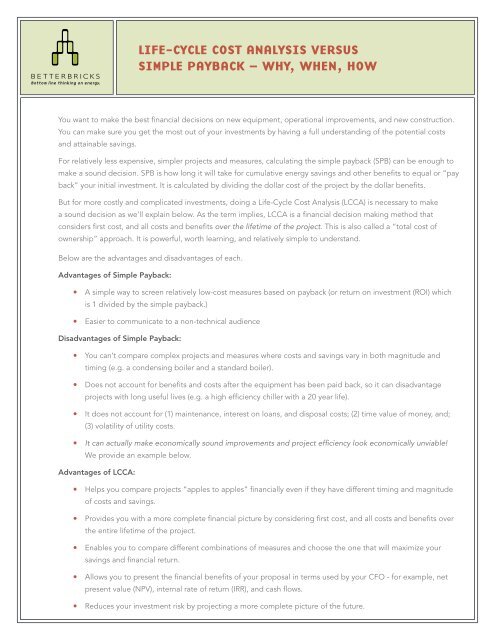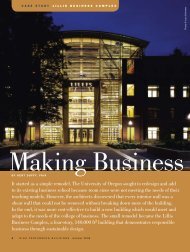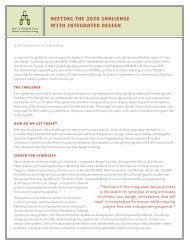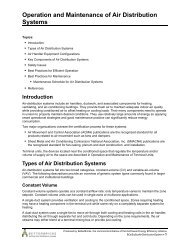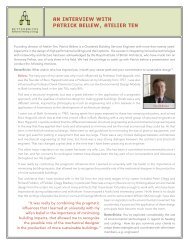Life-cycLe cost AnALysis versus simpLe pAybAck ... - BetterBricks
Life-cycLe cost AnALysis versus simpLe pAybAck ... - BetterBricks
Life-cycLe cost AnALysis versus simpLe pAybAck ... - BetterBricks
Create successful ePaper yourself
Turn your PDF publications into a flip-book with our unique Google optimized e-Paper software.
<strong>Life</strong>-cycle Cost Analysis <strong>versus</strong>Simple Payback – Why, When, HowYou want to make the best financial decisions on new equipment, operational improvements, and new construction.You can make sure you get the most out of your investments by having a full understanding of the potential <strong>cost</strong>sand attainable savings.For relatively less expensive, simpler projects and measures, calculating the simple payback (SPB) can be enough tomake a sound decision. SPB is how long it will take for cumulative energy savings and other benefits to equal or “payback” your initial investment. It is calculated by dividing the dollar <strong>cost</strong> of the project by the dollar benefits.But for more <strong>cost</strong>ly and complicated investments, doing a <strong>Life</strong>-Cycle Cost Analysis (LCCA) is necessary to makea sound decision as we’ll explain below. As the term implies, LCCA is a financial decision making method thatconsiders first <strong>cost</strong>, and all <strong>cost</strong>s and benefits over the lifetime of the project. This is also called a “total <strong>cost</strong> ofownership” approach. It is powerful, worth learning, and relatively simple to understand.Below are the advantages and disadvantages of each.Advantages of Simple Payback:A simple way to screen relatively low-<strong>cost</strong> measures based on payback (or return on investment (ROI) whichis 1 divided by the simple payback.)Easier to communicate to a non-technical audienceDisadvantages of Simple Payback:You can’t compare complex projects and measures where <strong>cost</strong>s and savings vary in both magnitude andtiming (e.g. a condensing boiler and a standard boiler).Does not account for benefits and <strong>cost</strong>s after the equipment has been paid back, so it can disadvantageprojects with long useful lives (e.g. a high efficiency chiller with a 20 year life).It does not account for (1) maintenance, interest on loans, and disposal <strong>cost</strong>s; (2) time value of money, and;(3) volatility of utility <strong>cost</strong>s.It can actually make economically sound improvements and project efficiency look economically unviable!We provide an example below.Advantages of LCCA:Helps you compare projects “apples to apples” financially even if they have different timing and magnitudeof <strong>cost</strong>s and savings.Provides you with a more complete financial picture by considering first <strong>cost</strong>, and all <strong>cost</strong>s and benefits overthe entire lifetime of the project.Enables you to compare different combinations of measures and choose the one that will maximize yoursavings and financial return.Allows you to present the financial benefits of your proposal in terms used by your CFO - for example, netpresent value (NPV), internal rate of return (IRR), and cash flows.Reduces your investment risk by projecting a more complete picture of the future.
Disadvantages of LCCA:Is harder to learn and apply.Getting input data can be challenging.SIMPLE PAYBACK VS. LIFE-CYCLE COST ANALYSIS: AN EXAMPLEThe figure above compares the savings for a small and a large energy-efficiency project both with 20-year lives.The small project <strong>cost</strong>s $200,000 and saves $100,000 annually (two-year simple payback) for five years before anadditional investment of $200,000 is needed.The large project <strong>cost</strong>s $700,000 and saves $184,000 annually (3.8-year simple payback) for 20 years, withreplacement <strong>cost</strong>s of $200,000 every five years.Which is a better investmenthe more <strong>cost</strong>-effective?Based on simple payback, the smaller project looks better. The larger project generates significantly more savingsbut the savings are in the future. Is it worth the investment?<strong>Life</strong>-cycle analysis can transform these future savings into today’s dollars using the concept of “time value of money.”At a 7% discount rate, and a 3% inflation rate, the smaller project saves only $550,000 in today’s dollars, while thelarge project saves $1,400,000! Would you pass up $850,000?<strong>Life</strong>-cycle Cost Analysis <strong>versus</strong> Simple Payback – Why, When, How2
WHEN TO USE LCCA VERSUS SIMPLE PAYBACKHere is a simple decision table for which to use:Simple Payback Analysis<strong>Life</strong>-Cycle Cost AnalysisFirst <strong>cost</strong> relatively small for your budget.First <strong>cost</strong> relatively high for your budget.Only one substantial life-cycle <strong>cost</strong>(e.g., electricity).Many life cycle <strong>cost</strong>s (e.g., electricity, gas, water,maintenance, etc.).Fairly even annual cash flowSubstantial variation in annual cash flowSimple equipment comparison (e.g., high efficiencyroof-top AC unit vs “code-minimum” unit).Projects where one decision impacts others (e.g.,daylighting/shading allows a smaller central plant).Installation of “off the shelf” equipment.Projects involving significant project design work.Below is a table of equipment common to hospitals and general guidelines for whether simple payback or life-cycle<strong>cost</strong> analysis is a good financial decision method.NOTE: See also the discussion of these types of equipment in the Energy Efficient Equipment PurchasingGuidelines tool.EquipmentFinancial Decision MethodLinear Fluorescent LampsCompact Fluorescent LampsElectronic Fluorescent BallastsExit SignsLighting ControlsSimple Payback (SPB) analysis enough unlesspart of one or more packages of measuresbeing analyzed. (Note: most utilities offergenerous incentives).Lighting FixturesWater-cooled chillers and cooling towersAir filtersSterilizer Economizers<strong>Life</strong>-Cycle Cost Analysis (LCCA). Consult withvendors on inputs for analysis.Hot Water BoilersDomestic Hot Water HeatersVariable Frequency DrivesN/A – savings come from how VFDs are applied,not differences in the VFDs themselves.Computers and Power Supplies No analysis necessary. Simply buy ENERGY STAR. ®Network-Level Computer Controls (ask vendorhow justified)LCCA – consult with vendor on inputs for analysis.<strong>Life</strong>-cycle Cost Analysis <strong>versus</strong> Simple Payback – Why, When, How3
TelevisionsPrinters, Fax Machines, CopiersIce Machines (prescriptive - ENERGY STAR)Refrigerators and FreezersBeverage Vending MachinesMedical EquipmentSPBNo analysis necessary. Simply buy ENERGY STAR.No analysis necessary. Follow FEMP guidelines.No analysis necessary. Simply buy ENERGY STAR.Ask your vendor about efficiency andpurchase <strong>cost</strong>.N/A – Savings come from where located and howintegrated into facility. No ENERGY STAR ratedequipment.HURDLE RATESFinancial “hurdle” rates for energy-related investments/purchases can help guide funding decisions. For example,fluorescent lamp purchase might be based on simple payback of a certain length. But the purchase of large andcomplex pieces of equipment like a chilled water system should be based on the Internal Rate of Return (IRR)determined by LCCA.Whether SPB or LCCA is used, hurdle rates should be based on all significant <strong>cost</strong>s and benefits – the total <strong>cost</strong> ofownership – not just energy. For example, a piece of equipment may be energy efficient, but if it has a relativelyshort lifetime compared to its standard counterpart, the <strong>cost</strong>s of periodic replacement (equipment and labor) maymake the efficient model not economic.Below are examples of financial hurdles that other organizations have used to decide whether to make an energyrelatedinvestment:Example Hurdle Rate: For items with a short lifetime (e.g. 5 years or less) and an initial <strong>cost</strong> of $500 or less,do a simple payback analysis and make the investment/purchase if the simple payback is 5 years or less.Example Hurdle Rate: For items with a long lifetime (e.g. 10 years or more) and/or an initial <strong>cost</strong> of $10,000or more, do a life-cycle <strong>cost</strong> analysis and make the investment/purchase if it has an IRR of 10% or better.ADDITIONAL RESOURCES AND LINKSFor a complete set of tools and resources, please go to www.betterbricks/healthcare.For more information on purchasing decisions, please see Guidelines for Energy Efficient EquipmentPurchasing. www.betterbricks.com/healthcare/tools&resourcesFor more details and an in depth discussion on LCCA, please see the Guide to Optimizing Hospital FacilityInvestments. For hospital facility managers, construction project managers, and other decision makers tohelp them more effectively evaluate the economic viability of energy-related investments in existing facilities,major renovations, and new construction. It also presents a range of project financing options.www.betterbricks.com/healthcare/tools&resources<strong>Life</strong>-cycle Cost Analysis <strong>versus</strong> Simple Payback – Why, When, How4


